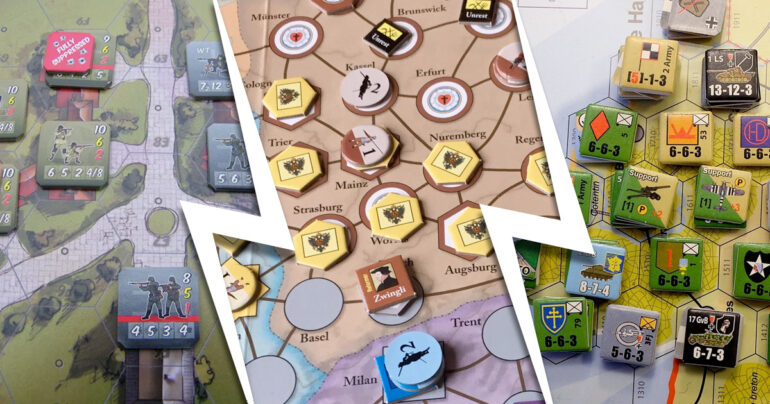When you first approach wargaming you’ll hear a lot about the “scale” of games, but really what’s being discussed is the “level of war”. It’s a tactical game, or a strategic game. Publishers don’t always tell you what the level is outright. So how important is it to know or understand this?
Let me clarify that I am not an expert, and I can feel the groans of those among you who have rehashed these conversations ad nauseum. While I hope to be a grognard one day, as of this writing I’m still pretty green. What I can tell you is that the level is a way of communicating something innate about a game, and most gamers find they enjoy games at a certain level more than others, so being able to identify it can be helpful.
Something to be aware of is that scale and level aren’t the same thing. The level talks about the types of activities you will be involved in, while the scale talks strictly about the size of units you are dealing with. Traditional hex and counter wargames have scales that are easier to classify in this way. Some may identify specifically as “a battalion level game” or a “regimental wargame”. Other wargames use more abstract systems, where scale isn’t always applicable – but they all will fall into a level of war.
With all that out of the way, let’s jump in.
Strategic
These games attempt to put players in charge of entire nations, empires, or coalitions. The focus is usually on a whole war, front, or theatre of operations. Players often have to deal with the politics, diplomacy, or economics of the conflict in some way. If military units are present they will be abstracted to something vague, or they may be huge in size – like armies, corps, or possibly divisions. Turns will usually be measured in days or weeks. Generally these games deal with the big picture.
Examples might be Cataclysm, The US Civil War, World In Flames, Triumph & Tragedy, Twilight Struggle, or Axis & Allies. See also Churchill or Pericles or Kingmaker.
Tactical
This is the exact opposite of Strategic games. At this level we’re talking about skirmishes or individual engagements upon a single field of battle (which may be small or large). Time scale will usually be hours or minutes per turn, and units will generally be company level or below, often down to platoons, squads, and maybe even individuals. In tactical games, unit facing is often a concern, and objectives are immediate and concrete. Clear that house. Hold that bridge.
The titan at this level is Squad Leader or Advanced Squad Leader. Other examples include The Great Battles Of History games (like SPQR or Samurai), Band Of Brothers, Men Of Iron, even the Command & Colors series of games (like Memoir 44, or C&C Napoleonics).
Grand Tactical games tend to focus on individual battles but do so inside a large theatre of operations, so they involve manoeuvring between battles. These tend to be set in the pre-industrial revolution era, like The Library Of Napoleonic Battles series of games. Post-industrial revolution, we tend to call these “operational”.
Operational
This is a newer (relatively) classification and straddles the line between tactical and strategic, so you’ll find they share some qualities of each, but also differ in key ways. Operational level games are larger than tactical games in that they don’t focus on one individual engagement, but rather on a campaign or an operation. They’re smaller than strategic games in that they tend to remain focused on military side of things. Units are typically smaller in scale than a strategic game and will include divisions, regiments, battalions, or possibly even companies. Turns will usually be measured in days or even hours.
Examples of Operational scale games might be Holland `44, Pacific War, Liberty Roads, Celles: The Ardennes, Silver Bayonet, or the games in the COIN or Levy & Campaign series.
There you have it. I hope this helps. If you feel I’ve overlooked some element here, or just messed something up, please let me know in the comments.

